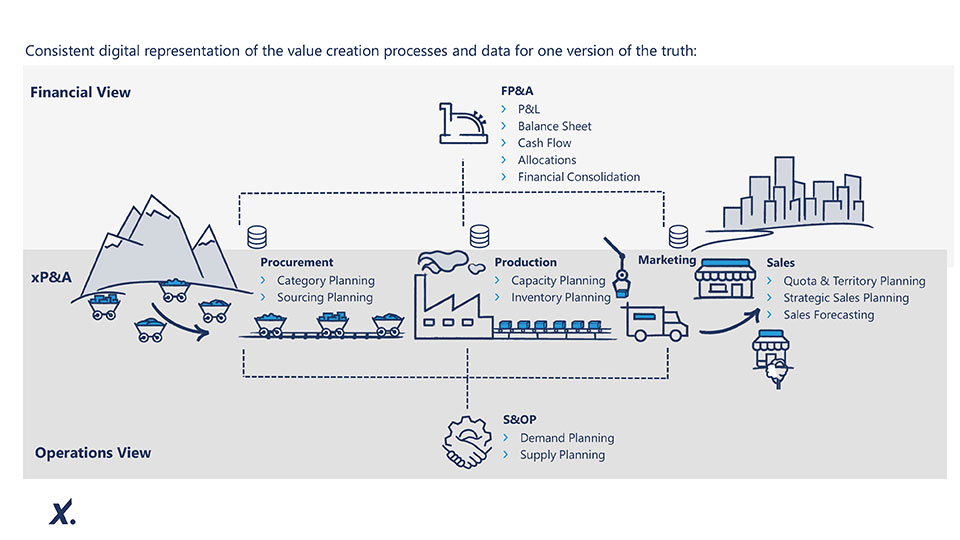Automation beyond the production line

In 2019, the manufacturing industry generated nearly 2 petabytes of new data, more than any other sector worldwide. And while manufacturing is one of the most automated industries in terms of production, most companies still rely on whiteboards and Excel spreadsheets when it comes to leveraging this data to manage, plan, and optimize their business. The fact is that such Excel solutions are not agile enough for a digital world. Automating processes such as planning, budgeting, and forecasting is.
According to a recent McKinsey survey, 66% of respondents claimed they were pursuing efforts to automate their processes across multiple business units. While automation is rising, only those businesses that upgrade their Office of the CFO will be able to keep pace with the rapid developments in the global market. Automation in the manufacturing industry is not only valuable for production, but for data management too.
Some facts:
- According to a recent Statista study, the automation industry is expected to generate around 214 billion USD worldwide this year while the process automation segment is expected to exceed 83 billion USD in 2021.
- Automation is vital to most modern industries, including industrial software development in the fields of tech, engineering, and scientific research. Industrial software alone is expected to be worth 43 billion USD this year.
- CFOs who embrace AI technology to encompass end-to-end processes such as record-to-report, order-to-cash will have a competitive advantage with more agility to scale quickly and efficiently.

The Case of Bystronic
As a leading global provider of high-quality solutions for the sheet metal processing industry, Bystronic has over 2,800 employees with operations in Switzerland, Germany, Italy and China. The company’s focus is on laser cutting systems, press brakes, and associated automation and software solutions with the goal of automating the complete material and data flow of the cutting and bending process chain.
Challenged with its lack of a proper solution for worldwide operational planning, Bystronic has sales and service subsidiaries strewn across more than 30 countries with agents located in numerous other countries. In the area of as-is reporting and financial consolidation, the company was already well positioned with several analytic tools, but its decentralized budgeting was still carried out with a time-consuming and error-prone Excel solution. The group controlling department decided to augment the existing CPM environment with an additional planning solution that combined planning functionality with intuitive analysis and visualization in a consistent, easy-to-use reporting platform. Within the time span of only six months, they were able to fully automate the planning process based on the simple operation of a user-friendly web-based solution instantaneously accessible to all locations.
The automated EPM solution allowed Bystronic controllers to refine the planning process independently and, for example, simply optimize data models or reports themselves. The central finance department can now adapt the system to real-time needs, giving the entire company a reliable overview of data that was inaccessible before the system switch. The integrated platform supports all phases of the reporting and planning processes with integrated data streams and a complete overview of the data. Current plan and actual comparisons are available at all times. It also allows both at the detailed controlling level and in a consolidated view of the financial statement preparation with balance sheet, P&L or cash flow. In the end, Bystronic has benefited from an improved ability to identify business drivers by simulating different planning scenarios, and more efficient budget management.
The benefit of automation for the manufacturing industry is illustrated in this graph:
Three Things to Consider about Automation
Automation is not about replacing human hands, but about augmenting their power. When considering how to go about automating business processes, three key areas need to be considered: existing systems, corporate culture, and collaboration.
Existing Systems
Executives know how time-consuming the planning process can be. It is often unstructured, cumbersome and prone to errors when basing all decisions solely on a massive pile of spreadsheets. In many cases, the separate spheres from the sales and finance departments have to be manually merged from multiple data sources. Planning directly in ERP systems can be both awkward and functionally limited. Proper forecasting is nearly impossible when relying on quickly outdated data due to rapid changes and market complexity.
If your existing system does not allow for easy data consolidation, it is time to consider a switch to a unified planning solution.
Corporate Culture
Change is never easy. When implementing new solutions, it is crucial to ensure all stakeholders are not only on board, but also involved in the process. Corporate culture is an important consideration when making the transition toward more automated processes. The Office of the CFO can act as an internal consultant to assist the various departments in embracing the new planning process. Executive decision-makers can position the change as a way of enhancing human productivity instead of replacing manual labor. Leveraging AI tools to increase access to real-time insights is one of example of such an enhancement.
Collaboration
Digitalization has increased the ability to embrace cross-departmental collaboration, which ultimately leads to higher quality data and insights. While Excel continues to play a significant role in the planning, budgeting and forecasting process, new tools are emerging to amplify its power. Smart executives are starting to recognize the need to shift toward automation to free up valuable human resources to focus on the future and all that it holds.
Written by Dr. Rolf Gegenmantel.
Add CEOWORLD magazine to your Google News feed.
Follow CEOWORLD magazine headlines on: Google News, LinkedIn, Twitter, and Facebook.
This report/news/ranking/statistics has been prepared only for general guidance on matters of interest and does not constitute professional advice. You should not act upon the information contained in this publication without obtaining specific professional advice. No representation or warranty (express or implied) is given as to the accuracy or completeness of the information contained in this publication, and, to the extent permitted by law, CEOWORLD magazine does not accept or assume any liability, responsibility or duty of care for any consequences of you or anyone else acting, or refraining to act, in reliance on the information contained in this publication or for any decision based on it.
Copyright 2024 The CEOWORLD magazine. All rights reserved. This material (and any extract from it) must not be copied, redistributed or placed on any website, without CEOWORLD magazine' prior written consent. For media queries, please contact: info@ceoworld.biz
SUBSCRIBE NEWSLETTER









